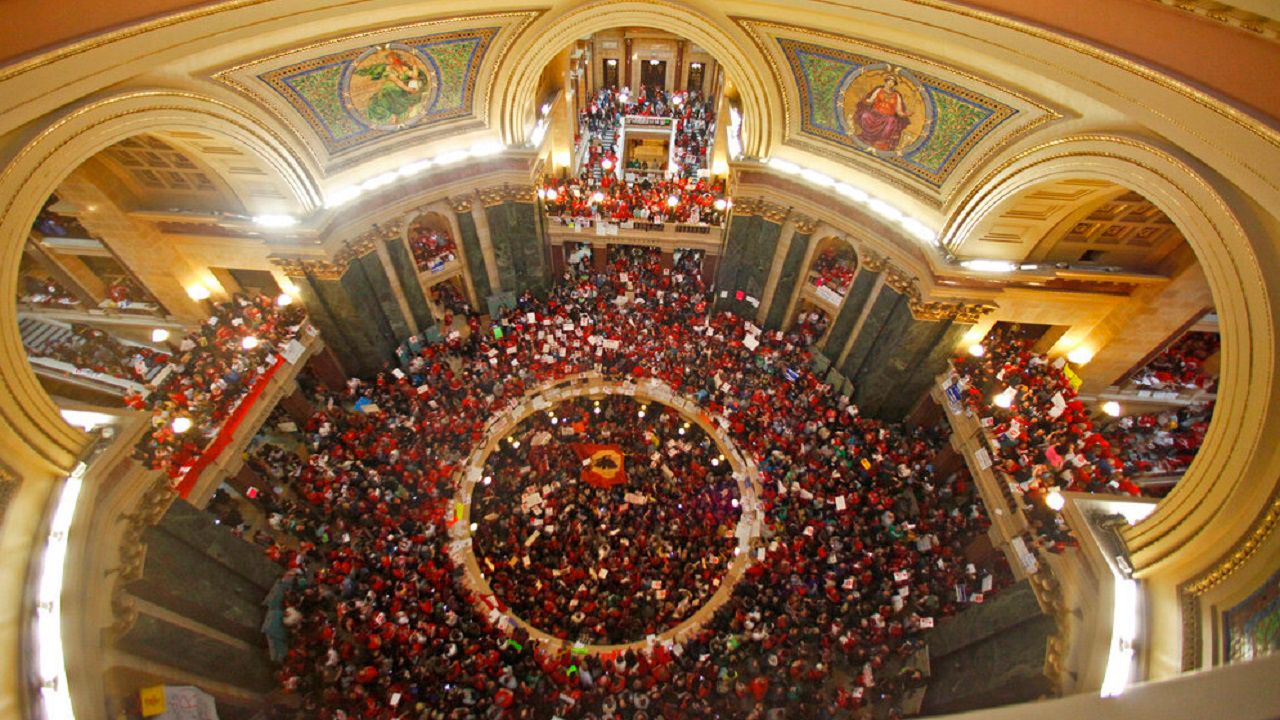MADISON, Wis. — For David Nack, being involved in the Act 10 protests was “an extraordinary time.”
Nack — a professor at UW-Madison’s School for Workers — remembers the swell of support not just from the public workers who would be directly affected, but also private-sector employees and others in the community.
While there were real money issues on the table, Nack said, he thinks the bigger piece that resonated with people was the threat to having “a meaningful union that represents you.”
“People thought more in terms of losing rights than just losing money,” Nack said.
Of course, despite the massive protests, Act 10 did pass through the legislature and went into effect 10 years ago this June — placing strong limits on how public-sector unions could operate and deal with their employers.
In the decade since then, union membership in the Badger State has seen a “precipitous decline,” said Michael Childers, a fellow School for Workers professor. But public-sector unions haven’t disappeared: Some have been able to evolve to meet the new moment, as Nack, Childers and their co-authors wrote in a 2019 study.
“Public worker unions have survived, despite this incredibly hostile environment that's been brought about,” Nack said.
* * *
Overall union membership in Wisconsin has dipped in the past decade, especially in the first few years after Act 10 took effect, according to data from the U.S. Bureau of Labor Statistics.
In 2010, before the legislation went through, 14.2% of all Wisconsin employees belonged to unions, the BLS reports. As of 2020, that number dropped to 8.7% — falling below the national average for union membership.
Overall, unions lost around 128,000 employees in Wisconsin in that decade, according to the report.
For Nack and Childers, that decline was no surprise. The conditions of Act 10 turned Wisconsin into a state that was historically a leader in public-sector unions, to one with some of the strictest labor legislation in the U.S.
“They essentially changed the law to make it extremely difficult for workers to maintain a union, and made the union’s role extremely limited in the workplace,” Childers said.
Under Act 10, unions have to hold a recertification vote every year to keep up their bargaining status. And to win that vote, the unions have to get support from 51% of all eligible employees — not just the majority of ballots cast, which means any no-shows count against the union.
Act 10 also made it harder for unions to collect dues, Nack said. Unions can no longer use a “dues checkoff” system, which automatically takes union fees out of members’ paychecks, and instead have to get workers to send dues to them separately.
Plus, the legislation restricted the scope of collective bargaining for the public-sector unions that did survive. Unions could now only negotiate over workers’ wages, and not benefits, workplace conditions or other policies.
For the Wisconsin Education Association Council — which represents teachers and other school staffers across the state — the legislation was “pretty devastating,” said WEAC president Ron Martin.
While some districts have been able to keep up strong labor relationships with teachers, he said others have seen those conversations devolve in the past decade.
“With the absence of the law mandating that we be at the table, and that we negotiate, and that we talk,” he said, “some districts that just kind of took advantage of that.”
* * *
Since Act 10 took effect, national trends have also shifted toward placing more limits on public worker unions, the UW researchers said.
“Wisconsin was the first state to codify collective bargaining as a legal thing in the public sector,” Childers said, “and then, ended up being sort of the canary in the coal mine as those rights have eroded across the country.”
Most U.S. states — including Wisconsin — have now enacted “right-to-work” laws, which mean unions can’t make membership mandatory or collect dues from non-members to cover bargaining costs. When Gov. Scott Walker signed Wisconsin’s right-to-work law in 2015, he said the change would attract more businesses and investment to the state.
Without the formal bargaining power of their pre-Act 10 days, some of Wisconsin’s public worker unions were “virtually wiped out,” Nack said. But others have kept holding on — with a new mindset of dealing.
“That's one of the things that Act 10 was not able to prohibit: It doesn't stop workers or their unions from talking to their employers,” Nack said. “They still can raise their concerns, and they can still organize and mobilize.”
Martin said that WEAC has leaned on more of a grassroots approach in the past decade.
Instead of keeping up their full lobbying presence in the legislature — WPR reports that WEAC dropped from 17 lobbyists in 2009 to just two in 2019 — he said the union is encouraging teachers to focus on pushing for change locally, getting in touch with their own school boards and legislators.
“We're back at the Capitol now, trying to push and encourage,” Martin said. “But we also know that the best and most effective way to address issues that are concerns of ours, but also of our students, is to do it one-on-one with legislators back home.”
WEAC has also brought a focus on racial and social justice to the forefront, he said, making sure its teachers are “better prepared to meet the needs of our Black and Brown students.”
Not all unions have succeeded in adapting to a post-Act 10 world, Nack said. “It’s very much a mixed bag.”
For those that have survived, though, it’s been a return to some of the most basic principles of unionizing.
“The organizations that have done the best after Act 10 have kind of gotten back to the roots of why workers formed organizations to begin with,” Childers said. “Workers have a community of interest. And it's about trying to have mutual aid and support each other in their work lives.”



